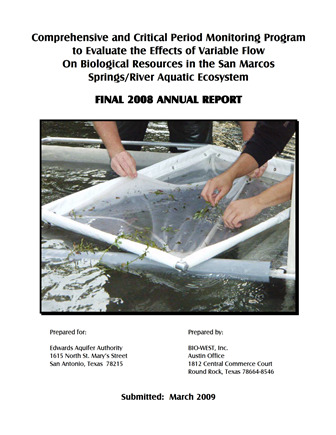Comprehensive and Critical Period Monitoring Program to Evaluate the Effects of Variable Flow on Biological Resources in the San Marcos Springs/River Aquatic Ecosystem Final 2008 Annual Report

| Summary |
|
The purpose of this report is to document the results of all aquatic ecosystem monitoring conducted in 2008 at San Marcos Springs located in San Marcos, Texas. The monitoring and report preparation was performed by BIO-WEST, Inc. Pflugerville, Texas. [Excerpted from the Executive Summary] For the fountain darter (Etheostoma fonticola), habitat use is largely influenced by aquatic vegetation, and assessments of habitat availability were conducted by mapping vegetation in the study reaches during each sampling event. With flows below average in 2008 there was a greater potential for anthropogenic disturbance because vegetation in shallow water areas became more accessible to recreation. This was observed at the Spring Lake Dam Reach between summer and fall where a section of Texas wild-rice plants appeared to be uprooted in the eastern spillway below Spring Lake. In addition, many rocks were moved to create dams and other structures in the area…. Vegetation in the City Park Reach increased by spring 2008, but decreased by fall. Lower flows in 2008 made typically deeper sections of this reach accessible to foot traffic during the summer and fall. As a result, Hydrilla decreased in surface are in the middle section of the reach. Hygrophila was one of the few vegetation types that increased when it filled in a section previously dominated by Sagittaria in the upper section of the City Park Reach. … Texas wild-rice increased 7 percent in surface area from 2007 and was the highest amount recorded by BIO-WEST since the inception of the study in 2001. As in previous years, most of the growth took place in the upper reaches of the San Marcos River…. As in 2007, fountain darter densities were highest in Cabomba and Hydrilla. Cabomba is a native vegetation type, while Hydrilla is non-native and considered to be very invasive. More fountain darters were found in the spring at the I-35 Reach than at the City Park Reach due to the presence of Cabomba. As in previous years, fountain darters collected in dip net sampling were most abundant at the Hotel Reach…. Length frequency analysis confirmed a spring reproductive peak of this endangered fish at all river sites. Fountain darter reproduction continues to be a year-round phenomenon within Spring Lake…. San Marcos salamander (Eurycea nana) densities increased at both Spring Lake sites in 2008 while decreasing slightly at the site below Spring Lake dam. Of the federally-listed species in the San Marcos system, the San Marcos salamander appears to be the least affected by lower flow conditions periodically observed over the time period covered by this study. The impacts when observed are typically due to increased recreational use of the river. Populations of San Marcos salamanders in Spring Lake have remained stable throughout the seven plus years of monitoring…. The past several years have exhibited different yearly flow regimes leading to a very informative flow sequence in the San Marcos River. After the lower flows of 2006, 2007 was a relatively average flow year, while 2008 was again considerably below average. Overall, the biological communities in the river have responded well to the flow sequence experienced these past several years…. If the current drought continues, 2009 may provide a valuable opportunity to examine how these species and their habitats respond to extended durations of lower flow conditions or more extreme low-flow conditions |
Search for Documents
Advance Search
Explore EAA's Scientific Reports
- All Reports
- Groundwater Movement
- Geomorphology and Caves
- Weather Modification
- Geology
- Water Use and Conservation
- Geochemistry
- Water Resources Planning and Management
- Floods and Drought
- Water Quality
- Climatology
- Surface Water / Groundwater Relationship
- Biology
- Springs, Groundwater Discharge
- Archaeology
- RZ Protection
- Aquifer Levels
- Remote Sensing
- Precipitation
- Overview Studies
- Modeling
- Hydrology and Hydrogeology
- History
- Groundwater Recharge, Recharge Zone
